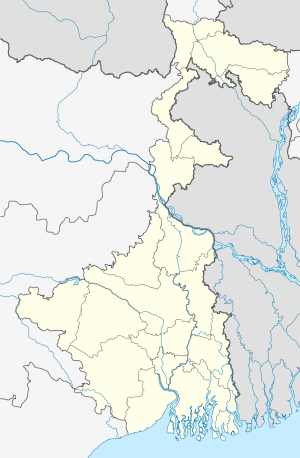Palashi
| Palashi Plassey | |
|---|---|
| town | |
 Palashi  Palashi Location in West Bengal, India | |
| Coordinates: 23°48′N 88°15′E / 23.80°N 88.25°ECoordinates: 23°48′N 88°15′E / 23.80°N 88.25°E | |
| Country |
|
| State | West Bengal |
| District | Nadia |
| Government | |
| • Body | Nagar Palika |
| Elevation | 17 m (56 ft) |
| Languages | |
| • Official | Bengali, English |
| Time zone | IST (UTC+5:30) |
| PIN | 741156 |
| Telephone code | 91 3474 |
| Vehicle registration | WB |
| Website |
wb |
Palashi (Bengali: পলাশী Pôlashi, pronounced [pəˈlaːsi]), also known as Plassey, is a village on the Bhagirathi river, located approximately 50 kilometres north of the city of Krishnanagar (কৃষ্ণনগর)in Kaliganj CD Block in the Nadia District of West Bengal, India. The nearest major town is Beldanga. It has its own two local gram panchayat.
It is particularly well known due to the Battle of Plassey fought there in 1757, between the private army of the British East India Company and the army of the king of Bengal Nawab Siraj Ud Daulah.[1]
Etymology
The name Palashi is derived from the Bengali word for the red flower Pôlash (Bengali: পলাশ, English: Butea, Latin: Butea frondosa or Butea monosperma).
History
Palashi achieved historical significance when, on 23 June 1757, the Battle of Plassey was fought between the forces of Siraj Ud Daulah, the last Nawab of Bengal (and his French support troops) and the troops of the British East India Company, led by Robert Clive. This event, part of the Seven Years' War, ultimately led to the establishment of British rule in Bengal, and eventually, the whole Indian subcontinent. During British rule Plassey became part of Nadia District of Bengal.[2]
Geography
Palashi is located in West Bengal,India at 23°48′N 88°15′E / 23.80°N 88.25°E.[3] It has an average elevation of 17 m (56 ft).
Culture and Memorials
The grounds where the historic Battle of Plassey was fought is today marked with shrines, obelisks and memorials to the fallen generals and soldiers of Siraj Ud-Daulah. A set of three obelisks marks homage to the spot where Bakshi Mir Madan (the chief of the Nawab's artillery), Bahadur Ali Khan (Commander of Musketeers) and Nauwe Singh Hazari (the Captain of Artillery) were killed in the battle. A plaque indicates that they fell here at 2 p.m on 23 June 1757 and were leaders of Nawab Siraj-Ud_Daula, at the head of the charge ordered by Mir Madan.[4]
A gold coloured statue of Siraj Ud Daula lies next to them, in a clearing amidst mango orchards and fields. The tombs of Siraj Ud Daulah, Mir Jafar, their wives and a number of generals in Siraj's army lie close by around Murshidabad.[5][6] Mausoleums built around the tombs of Siraj Ud-Daula, Azimunessa begum and other soldiers who fell in the war can be found close by at Khosh Bag and Jafarganj cemetery.[7]
References
- ↑ Robins, Nick. "This Imperious Company - The East India Company and the Modern Multinational - Nick Robins - Gresham College Lectures". Gresham Colelge Lectures. Gresham College. Retrieved 19 June 2015.
- ↑ Plassey - Imperial Gazetteer of India, v. 20, p. 156.
- ↑ Falling Rain Genomics, Inc - Palashi
- ↑ Barua, Ashis. "Palashi, Murshidabad". You Tube. Ashis Barua. Retrieved 19 June 2015.
- ↑ Bhattacharya, Rajib Kumar. "War memorial at Palasi, Murshidabad". Flickr. Flickr. Retrieved 19 June 2015.
- ↑ Bhattacharya, Rajib Kumar. "Photos of Murshidabad and Palasi". Murshidabad Travel Guide. Blogspot. Retrieved 19 June 2015.
- ↑ Basu, Saurab. "Trip Taken from June – 10th to 12th - 2006". Murshidabad – The Land of the Legendary ‘Siraj-ud-dullah’ Unveiled. History of Bengal. Retrieved 19 June 2015.